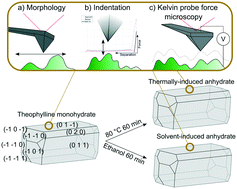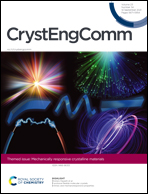Effect of dehydration pathway on the surface properties of molecular crystals†
Abstract
Molecular crystals with water molecules in the crystal lattice (hydrates) can radically change properties if dehydrated. The two most practically relevant pathways of dehydration can be classified as either thermally-induced or solvent-induced. The solid form transformations occurring during these processes are taking place at the surface of the particles either in the solid–gas or solid–liquid interface. In this study, it is demonstrated how atomic force microscopy (AFM) can be used to measure topography, elastic modulus and work function to elucidate differences at the crystal surface depending on the dehydration pathway. These results are performed at a single particle level, so it would be important to link the findings to the bulk powder behaviour. To address this, static charging measurements for bulk powder samples were compared with the single crystal surface measurements. The thermally-induced anhydrate acquired more charge than the monohydrate at the bulk level which could be explained by the increase in work function and surface roughness at a single particle level. The change in sign for the solvent-induced anhydrate was also in agreement with the work function. This underpins the importance of also considering microscale properties, when characterizing nanoscale structures at the surface of particulate systems.

- This article is part of the themed collections: Crystal Engineering Techniques and Mechanically responsive crystalline materials


 Please wait while we load your content...
Please wait while we load your content...